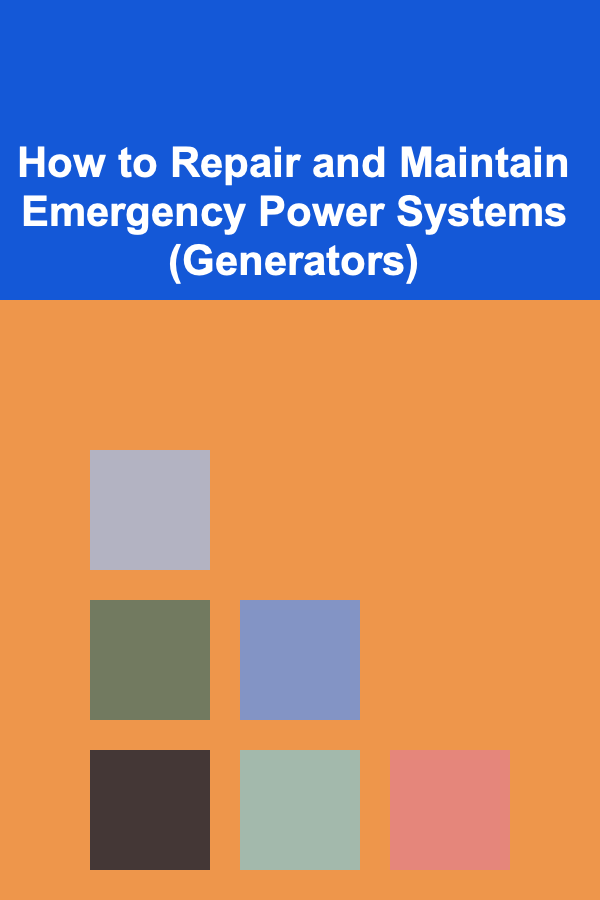
How to Repair and Maintain Emergency Power Systems (Generators)
ebook include PDF & Audio bundle (Micro Guide)
$12.99$10.99
Limited Time Offer! Order within the next:

Emergency power systems, particularly generators, are a crucial component in ensuring a reliable backup power supply during power outages or emergencies. Whether it's for a residential home, commercial establishment, or critical infrastructure, a well-maintained generator can mean the difference between security and vulnerability when the grid fails. However, like any mechanical system, generators require regular maintenance and occasional repairs to operate efficiently and safely.
This article provides an in-depth guide on how to repair and maintain emergency power systems, focusing on various types of generators, including diesel, gasoline, and natural gas-powered models. Understanding the components, common issues, maintenance tips, and troubleshooting procedures will help you ensure your generator is ready for use when it's needed most.
Understanding Emergency Power Systems (Generators)
Types of Emergency Power Systems
Generators come in a variety of types, each designed for different applications. Understanding the type of generator you have will be crucial in knowing how to maintain and repair it. The main types of emergency power systems include:
- Portable Generators: These are typically small, gasoline-powered units designed for short-term use. They are perfect for smaller homes or temporary applications, such as camping or tailgating.
- Standby Generators: Larger and more permanent, these systems are typically powered by natural gas, propane, or diesel. Standby generators are designed to automatically start when the main power supply fails and can power an entire home or facility for extended periods.
- Inverter Generators: These are more advanced portable units that provide clean, stable power suitable for sensitive electronics. They are quieter and more efficient than traditional portable generators.
- Diesel Generators: These are large, industrial-grade generators used for high-demand backup power. Diesel engines are durable and efficient, making them ideal for businesses, hospitals, or any facility requiring continuous power.
Components of a Generator
Before diving into maintenance and repair, it's essential to understand the basic components of a generator. Key components include:
- Engine: Powers the generator, converting fuel into mechanical energy.
- Alternator: Converts mechanical energy into electrical energy.
- Fuel System: Includes the fuel tank, fuel lines, and injectors, providing the generator with the necessary fuel.
- Cooling System: Prevents the engine from overheating during operation.
- Lubrication System: Keeps the engine parts lubricated to reduce friction and wear.
- Control Panel: Provides the operator with status information, such as fuel levels, operating hours, and any warning signals.
- Exhaust System: Expels harmful gases produced by the engine, typically through a muffler.
- Battery: Supplies power to start the generator and operates certain control functions.
Common Generator Problems
Understanding the common issues that can affect your generator is the first step toward repairing and maintaining it. Some typical problems include:
- Starting Problems: If your generator won't start, it could be due to fuel issues, a dead battery, or an ignition system malfunction.
- Overheating: Generators that overheat could have problems with the cooling system, dirty air filters, or blocked vents.
- Low Voltage Output: This may be caused by worn-out components in the alternator, loose connections, or a malfunctioning voltage regulator.
- Fuel Issues: Fuel line clogs, old fuel, or improper fuel type can prevent the generator from running effectively.
- Excessive Noise: Noise levels may increase due to worn-out engine parts, loose components, or poor maintenance.
- Exhaust Problems: Blockages in the exhaust system can cause dangerous fumes to accumulate.
Maintenance of Emergency Power Systems
Proper maintenance is key to ensuring your generator remains in good working condition and is ready for use when required. Regular servicing will not only extend the life of your generator but also minimize the likelihood of needing major repairs. The following maintenance tasks are essential for keeping your emergency power system in optimal condition.
1. Regularly Inspect and Clean the Generator
Inspection:
- Check for signs of wear, rust, or leaks around the generator's fuel system, engine, and exhaust system.
- Examine the battery terminals to ensure they are free of corrosion and properly connected.
- Inspect the air filters for dirt or debris, as a clogged filter can reduce engine efficiency.
Cleaning:
- Clean the external parts of the generator to prevent dirt, dust, and grime buildup. Use a damp cloth and mild soap to wipe down surfaces.
- Clean or replace the air filter regularly, as a clogged filter can restrict airflow and reduce efficiency.
- Ensure the vents are clear to allow for proper airflow, helping the generator maintain the right temperature during operation.
2. Change the Oil and Replace the Oil Filter
Like any engine, generators require regular oil changes to ensure smooth operation. Over time, oil breaks down and becomes contaminated with dirt, which can lead to engine wear.
Steps for Changing Oil:
- Check the owner's manual for the recommended oil type and change interval.
- Ensure the generator is turned off and cooled down before draining the oil.
- Drain the oil by removing the drain plug and letting the oil flow into a container.
- Replace the oil filter (if applicable) and refill the engine with fresh oil.
- Dispose of the used oil properly according to local regulations.
3. Examine and Replace the Fuel Filter
The fuel filter prevents contaminants from entering the engine, ensuring smooth fuel flow. Over time, fuel filters can become clogged, leading to poor engine performance.
Steps for Replacing the Fuel Filter:
- Consult the generator's manual for instructions on locating the fuel filter.
- Turn off the generator and disconnect the fuel supply before replacing the filter.
- Remove the old fuel filter and replace it with a new one that matches the specifications.
- Reconnect the fuel supply and check for any fuel leaks.
4. Check the Battery and Electrical System
The battery is essential for starting the generator and powering the control panel. It's important to keep the battery in good condition.
Steps for Battery Maintenance:
- Clean the battery terminals and ensure they are free from corrosion. You can use a mixture of baking soda and water to clean the terminals.
- Check the battery voltage with a multimeter to ensure it is properly charged.
- If the battery shows signs of deterioration or no longer holds a charge, replace it with a new one.
5. Monitor the Cooling System
A malfunctioning cooling system can lead to generator overheating, potentially causing severe engine damage. Regularly inspect the coolant levels and ensure the system is functioning correctly.
Steps for Cooling System Maintenance:
- Check the coolant levels and top them off if necessary.
- Inspect the coolant hoses and connections for any signs of leaks or wear.
- Clean the radiator and ensure that there is no obstruction to airflow.
- In some cases, you may need to flush the cooling system and replace the coolant at the intervals specified in the owner's manual.
6. Test the Generator Regularly
Performing regular tests is an essential part of generator maintenance. Testing ensures that the generator will start up properly and can run for an extended period without issues.
Steps for Testing:
- Start the generator and let it run for at least 20-30 minutes under load.
- Check that the generator operates smoothly without unusual noises, vibrations, or fluctuations in voltage.
- Test the generator's transfer switch to ensure it automatically transfers power during a power outage.
7. Fuel System Maintenance
The fuel system is critical to the operation of your generator. Improper fuel can lead to poor engine performance, clogged fuel lines, and even damage to the fuel injectors.
Fuel System Tips:
- Always use the recommended fuel type for your generator.
- If the generator is going to be out of use for an extended period, consider draining the fuel tank to prevent fuel from deteriorating and clogging the system.
- Store fuel in a cool, dry place, away from direct sunlight, and ensure it is in an airtight container to prevent contamination.
Troubleshooting Common Generator Problems
Even with regular maintenance, generators can sometimes develop issues that need to be addressed. Here are some common problems and troubleshooting steps:
1. Generator Won't Start
Possible Causes:
- Dead battery
- Faulty spark plug
- Empty fuel tank
Troubleshooting Steps:
- Check the battery and replace it if necessary.
- Inspect the spark plug for wear and replace it if needed.
- Ensure there's enough fuel in the tank and that it is fresh.
2. Generator Runs Rough or Stalls
Possible Causes:
- Clogged air filter
- Dirty carburetor
- Low oil level
Troubleshooting Steps:
- Clean or replace the air filter.
- Clean the carburetor and ensure the fuel lines are not clogged.
- Check and top off the oil level if necessary.
3. Low Voltage Output
Possible Causes:
- Faulty alternator
- Voltage regulator issues
Troubleshooting Steps:
- Inspect the alternator for damage and replace if necessary.
- Check the voltage regulator and replace it if it is malfunctioning.
4. Excessive Noise or Vibration
Possible Causes:
- Loose engine parts
- Worn-out bearings
Troubleshooting Steps:
- Tighten any loose bolts or engine parts.
- Inspect the bearings and replace them if necessary.
Conclusion
Maintaining and repairing emergency power systems, particularly generators, is essential to ensuring they remain functional during power outages or other emergencies. Regular maintenance, such as oil changes, fuel system checks, and battery inspections, can extend the lifespan of your generator and minimize the risk of breakdowns. Additionally, knowing how to troubleshoot and repair common issues will help you keep your generator in optimal condition.
By following the maintenance tips and troubleshooting guidelines outlined in this article, you can ensure that your emergency power system is always ready to provide reliable power when you need it most.
Reading More From Our Other Websites
- [Home Lighting 101] How to Feature Large Glass Pendant Lights in Your Kitchen Island Design
- [Organization Tip 101] How to Keep Seasonal Decorations Organized in Your Entryway
- [Home Budget 101] How to Track Your Expenses Without Overwhelm
- [Personal Care Tips 101] How to Exfoliate Your Face Without Overdoing It
- [Personal Care Tips 101] How to Revitalize Dry Nails and Cuticles with Cuticle Oil
- [Whitewater Rafting Tip 101] From Calm to Chaos: Understanding Water Level Forecasts for Optimal Rafting Planning
- [Organization Tip 101] How to Organize Your Music Playlist for Easy Listening
- [Personal Care Tips 101] How to Build an At-Home Pilates Routine for Back Pain Relief
- [Home Rental Property 101] Best Methods to Rent Out Your Property and Earn Extra Income
- [Tiny Home Living Tip 101] Best Ways to Incorporate Vertical Gardens into Tiny Home Interiors

How to Choose the Best Party Favors for Your Home Celebration
Read More
How to Remove Pet Odors from Your Home
Read More
How to Set Up a Family Home Olympics for Bonding
Read More
Why You Should Use a Whiteboard for Daily Reminders
Read More
How To Discover Cinematic Scores and Their Composers
Read More
10 Tips for Mobile App Testing and Debugging
Read MoreOther Products

How to Choose the Best Party Favors for Your Home Celebration
Read More
How to Remove Pet Odors from Your Home
Read More
How to Set Up a Family Home Olympics for Bonding
Read More
Why You Should Use a Whiteboard for Daily Reminders
Read More
How To Discover Cinematic Scores and Their Composers
Read More